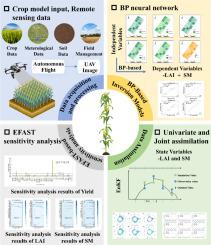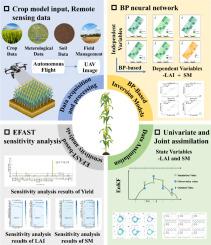Improvement of crop growth simulations under different drip irrigation modes by jointly assimilating UAV multimodal data into crop models
IF 5.7
1区 农林科学
Q1 AGRONOMY
引用次数: 0
Abstract
Accurate crop monitoring is essential for agricultural planning and food security. This study developed a coupling framework of unmanned aerial vehicle (UAV) multimodal data and crop models based on a sequential data assimilation method, offering technical support for crop growth simulation and precision management under drip irrigation modes in the Hexi Corridor of Northwest China. Multispectral and thermal infrared image data of spring maize at different growth stages were acquired via UAVs. The UAV-derived leaf area index (LAI) and soil moisture (SM) were assimilated into the WOFOST model using the ensemble Kalman filter (EnKF). Three assimilation schemes including (a) LAI, (b) SM, and (c) LAI+SM were compared to explore the effects of different mulching treatments (mulched vs. non-mulched) and irrigation gradients on assimilation performance under drip irrigation modes. Our results showed that the fusion of UAV-based multispectral and thermal infrared multimodal data enabled accurate retrieval of LAI and SM, with a maximum R² of 0.85. The three assimilation schemes exhibited significant differences, and the joint assimilation of LAI and SM outperformed the others. This may be since LAI and SM, as key indicators of crop growth and development, undergo dynamic changes throughout the growth period, and their joint assimilation fully captures the temporal variability of crops and soil. In addition, the proposed framework demonstrated marked variations in simulation accuracy across different drip irrigation modes. Overall, the performance for shallow buried drip irrigation (SBDI) was superior to that for surface drip irrigation (SDI) and film-mulched drip irrigation (FDI). This may be attributed to the direct influence on soil evaporation and evapotranspiration under the latter two modes, which in turn modifies crop growth and development processes and ultimately affects the model's simulation accuracy.


将无人机多模态数据联合同化到作物模型中,改进不同滴灌模式下作物生长模拟
准确的作物监测对农业规划和粮食安全至关重要。基于序列数据同化方法,构建了无人机多模态数据与作物模型的耦合框架,为河西走廊滴灌模式下作物生长模拟与精准管理提供技术支撑。利用无人机采集了春玉米不同生育期的多光谱和热红外图像数据。利用集合卡尔曼滤波(EnKF)将无人机反演的叶面积指数(LAI)和土壤湿度(SM)同化到WOFOST模型中。比较(a) LAI、(b) SM和(c) LAI+SM 3种同化方案,探讨滴灌模式下不同覆盖处理(覆盖与不覆盖)和灌溉梯度对同化性能的影响。结果表明,基于无人机的多光谱和热红外多模态数据融合可以准确地检索LAI和SM,最大R²为0.85。3种同化方案差异显著,LAI和SM联合同化效果优于其他同化方案。这可能是因为LAI和SM作为作物生长发育的关键指标,在整个生育期都是动态变化的,它们的联合同化充分捕捉了作物和土壤的时间变异性。此外,所提出的框架在不同滴灌模式下的模拟精度有显著差异。总体而言,浅埋滴灌(SBDI)的表现优于地表滴灌(SDI)和地膜滴灌(FDI)。这可能是由于后两种模式直接影响了土壤蒸发量和蒸散量,进而改变了作物生长发育过程,最终影响了模型的模拟精度。
本文章由计算机程序翻译,如有差异,请以英文原文为准。
求助全文
约1分钟内获得全文
求助全文
来源期刊
CiteScore
10.30
自引率
9.70%
发文量
415
审稿时长
69 days
期刊介绍:
Agricultural and Forest Meteorology is an international journal for the publication of original articles and reviews on the inter-relationship between meteorology, agriculture, forestry, and natural ecosystems. Emphasis is on basic and applied scientific research relevant to practical problems in the field of plant and soil sciences, ecology and biogeochemistry as affected by weather as well as climate variability and change. Theoretical models should be tested against experimental data. Articles must appeal to an international audience. Special issues devoted to single topics are also published.
Typical topics include canopy micrometeorology (e.g. canopy radiation transfer, turbulence near the ground, evapotranspiration, energy balance, fluxes of trace gases), micrometeorological instrumentation (e.g., sensors for trace gases, flux measurement instruments, radiation measurement techniques), aerobiology (e.g. the dispersion of pollen, spores, insects and pesticides), biometeorology (e.g. the effect of weather and climate on plant distribution, crop yield, water-use efficiency, and plant phenology), forest-fire/weather interactions, and feedbacks from vegetation to weather and the climate system.

 求助内容:
求助内容: 应助结果提醒方式:
应助结果提醒方式:


